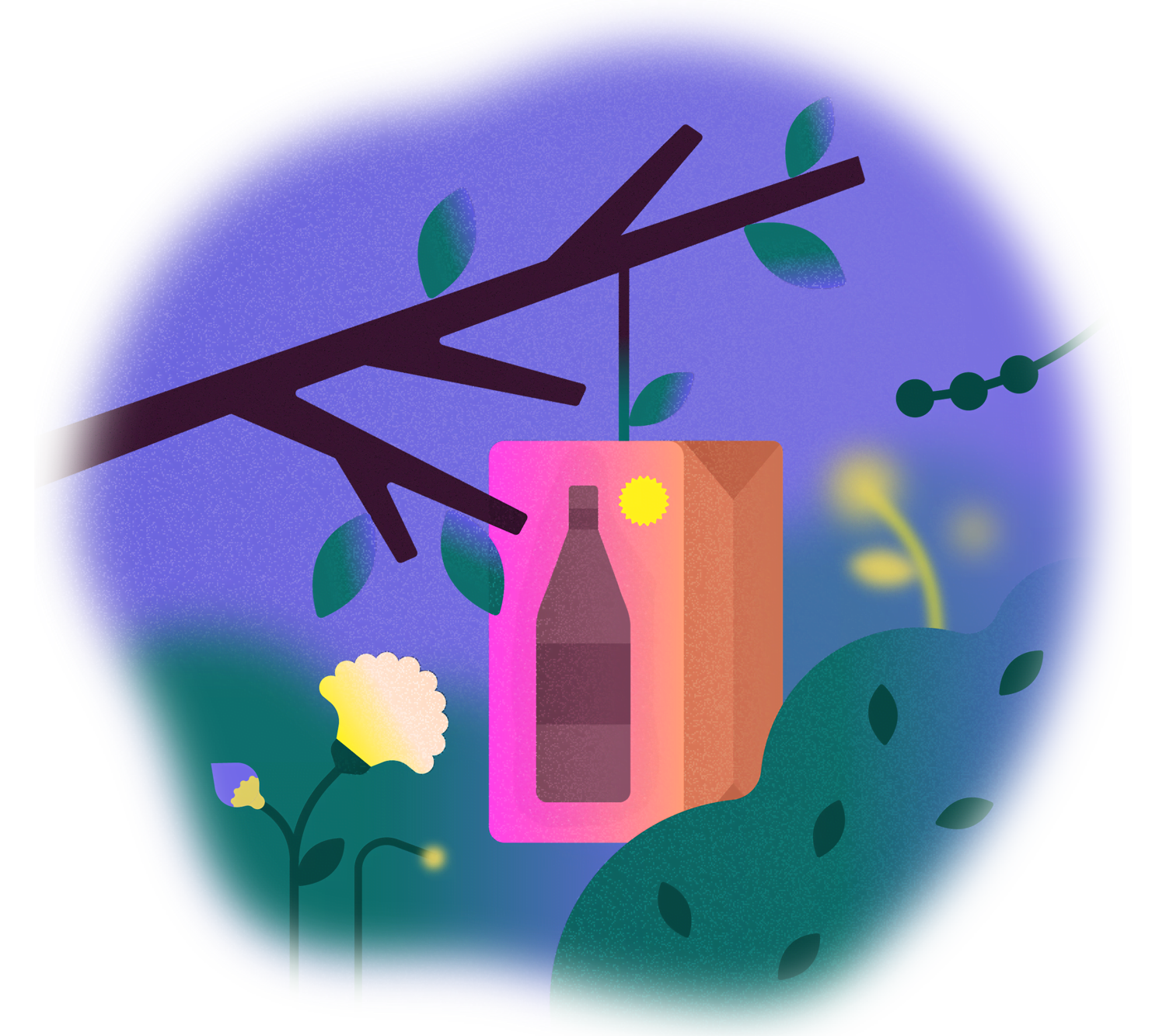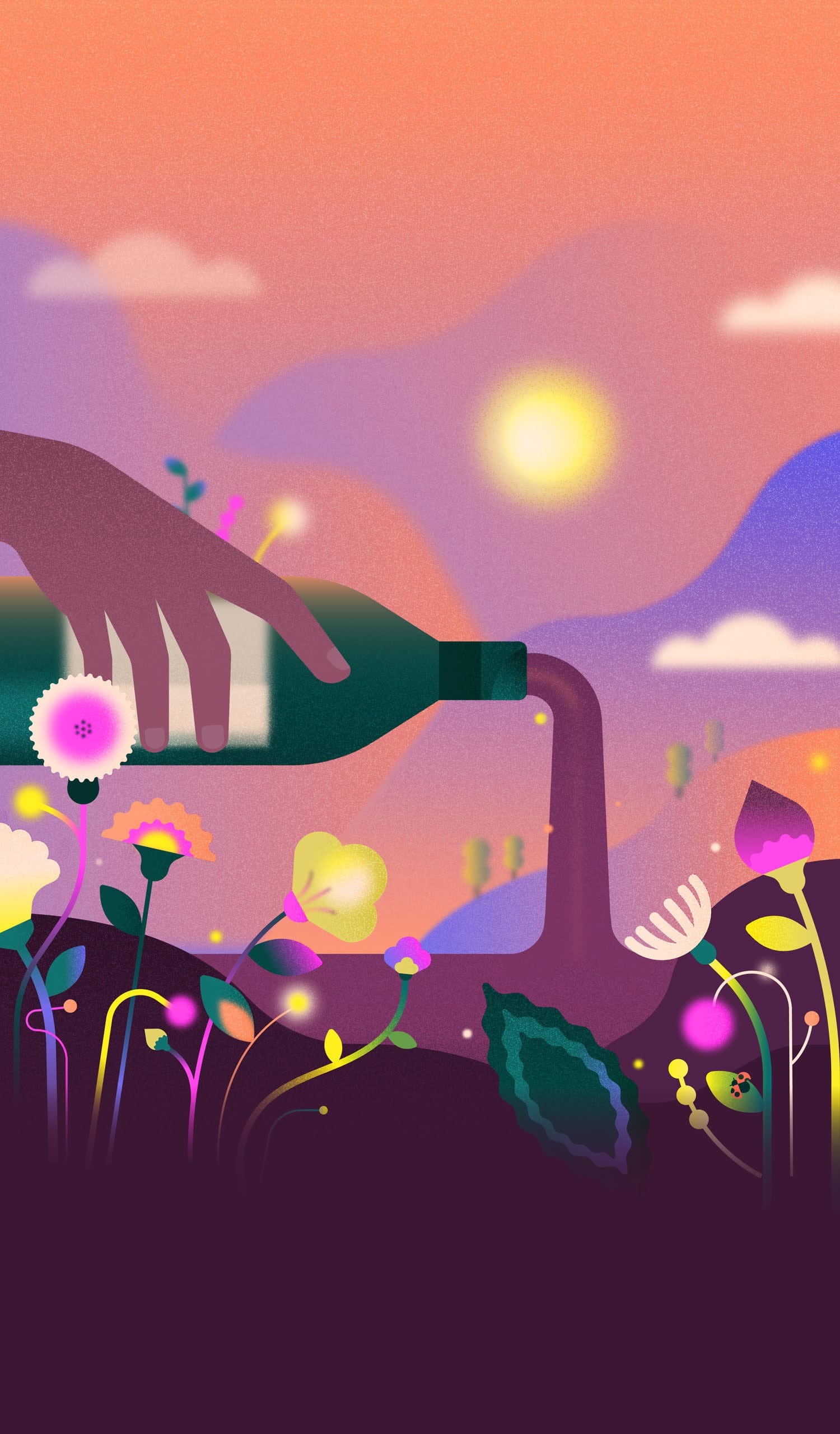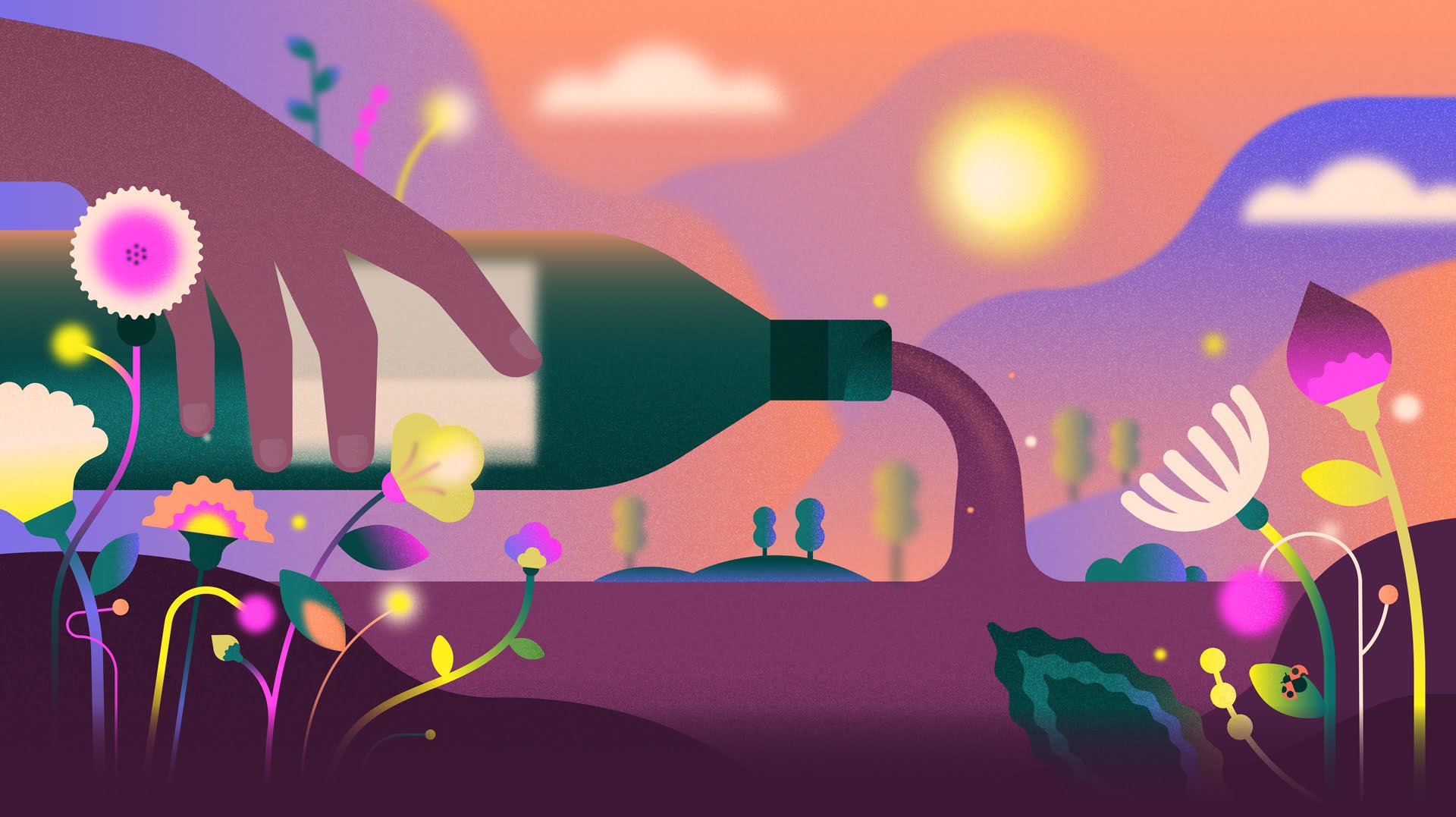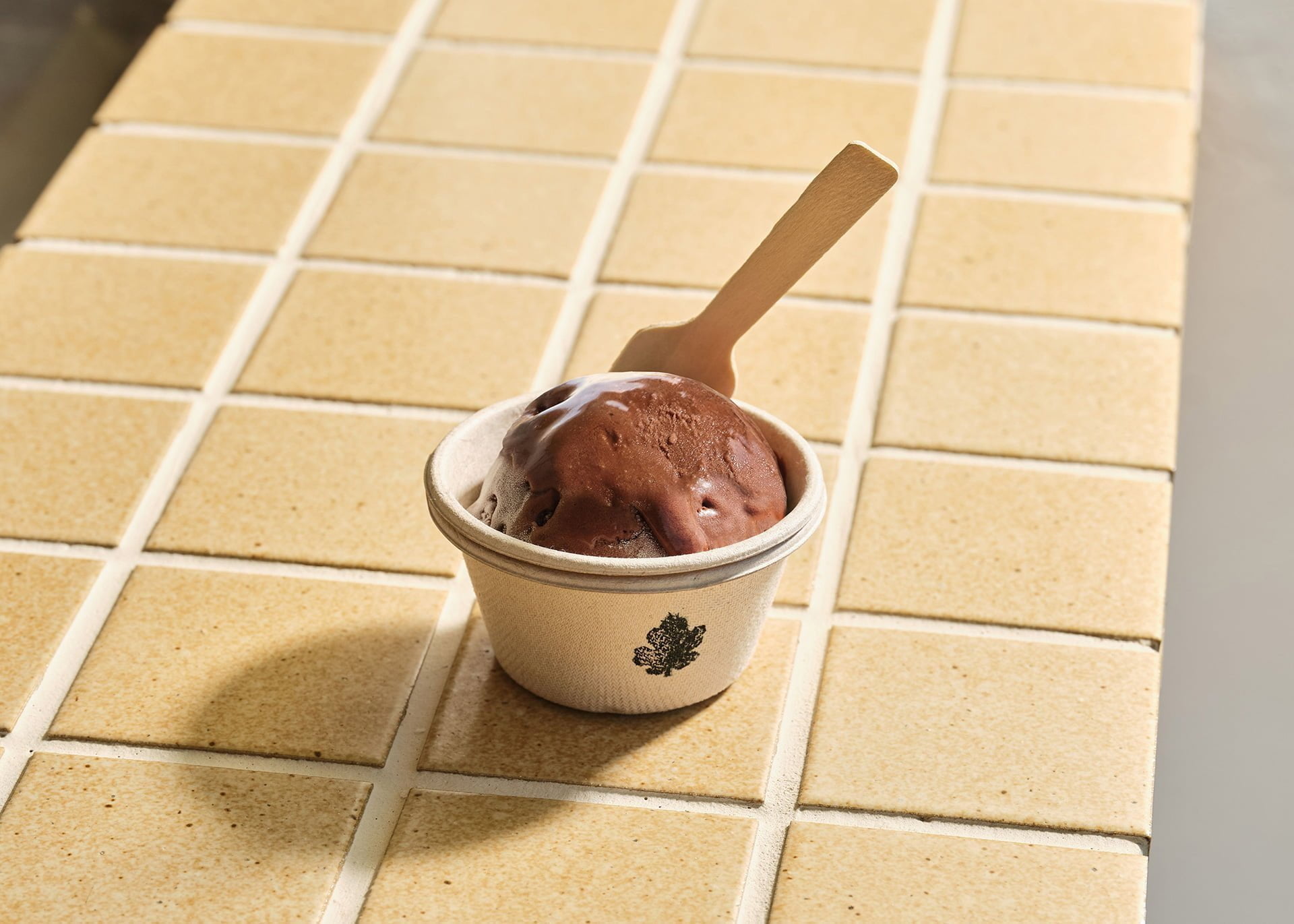If you’re concerned about the climate crisis and you drink wine, there are some things you need to know. Curl up with a glass and read our guide.
It’s bleakest January, snow covering the sidewalks, and you see a watermelon in the grocery store. You don’t have to be a sustainability expert to see there’s an issue here: we know that produce shipped from far away has a higher footprint than local, seasonal food.
But what about wine? After all, the wine section of any store is a veritable tour of the planet. Can it be kind to the planet at the same time?
“Growing grapes and making wine is probably one of the lowest impact agriculture crops in the world,” says wine climatologist Greg Jones, Ph.D., who recently became the CEO of Abacela, his family’s winery in Southern Oregon. But “the fact that wine is shipped all over the world is just as bad as the watermelon being in a store in New York City in January.”
Working out the real impact of the wine you drink – all the way from the grapes to the bottle to the truck that brought it to your local store – requires paying a little attention. Lucky for you, there’s a lot more “sustainable” wine now than ever—and data from International Wine & Spirits Research shows that consumers are willing to pay more for it. So, refill your glass. Here’s our guide.

1. Buy locally-made wines
When it comes to food, most climate warriors know that, as well as avoiding the foods with the biggest climate impact, like most beef and dairy, it helps to buy food that is grown locally and in season. If your food comes from a nearby farm or ranch, you’re reducing the “food miles” that it takes to get it from its source to your dinner plate.
“Wines should be bought locally just like everything else”
Greg Jones, Abacela
But while we’ve learned to value local food, that’s not how we tend to look at wine. “We’re in a system that’s selling geography,” says Greg Jones of Abacela. “Wines should be bought locally just like everything else should be.”
If you live in a state like Oregon, California, Washington – or even New York, Texas, or Virginia – that has a wine industry, you’re in luck. Buy directly from local winemakers or from shops that feature them. If you don’t, try to find wines that are from your region.
But here comes an important caveat. Most wine from overseas is transported by ship, so it’s less carbon intensive than if it were flown. “Far more important are the road miles—a bottle of wine transported by road across the U.S. will have the highest footprint, no matter where it was originally shipped from,” says Mike Berners-Lee in his book The Carbon Footprint of Everything.
2. Buy wines without chemical inputs
Pesticides and herbicides used in agriculture seep into our waterways, contaminating ecosystems and building up in creatures, some of which we eventually consume. They’re also dangerous to the workers who farm the vineyards. In the U.S., there are at least three different farming certifications that eschew chemical inputs and commercial fertilizers.
“Anything with a ‘cide’ appended to it [herbicide, pesticide, fungicide] is intended to kill things,” says Eric Lemelson, owner of Lemelson Vineyards, one of the first Oregon vineyards to be certified organic. “And we are a biological life form, so I don’t want my crew spraying something that I wouldn’t want to spray myself. Period. End of story.” Lemelson’s vineyards were certified organic in 2004.
“Organic grapes don’t automatically mean organic wine”
A wine made with organic grapes (certified by a third-party organization that works with the United States Department of Agriculture), means that most synthetic pesticides, herbicides or any chemical fertilizers are forbidden in the vineyard. Organic grapes don’t automatically mean organic wine: to get a wine certified organic, a winemaker must go a step further, not using any sulfites during bottling. (Sulfites, also known as sulfur dioxide, are a chemical compound that preserve freshness and prevent oxidation.)
The United States also has over 80 biodynamic vineyards, certified by an organization called Demeter. These eschew synthetic pesticides and fertilizers, and also stick to a further set of guidelines. Biodynamic wineries must integrate livestock and compost on their vineyards, to increase the fertility of the soil, plant cover crops, and use approved natural methods to look after soil and plant health.

Like with the ‘organic’ label, biodynamic grapes don’t automatically mean biodynamic wine. To call your wine biodynamic you also need to use no imported yeasts, no pasteurization, no plastic containers as storage vessels, and a limited amount of sulfite for bottling, among other strictures.
If you’re a wine drinker, you’ve probably noticed the term natural wine on restaurant menus and at wine shops lately. While there’s no universal definition or set of requirements for natural wine, the ethos is simple: sourcing organically-grown fruit and using minimal intervention in the cellar. Most mass-produced wine is made with additives, ranging from added sugar and dry powdered fish bladder (for fining purposes) to something called Mega Purple (a grape concentrate used to “plump up” the color of a pale red wine and add a jammy flavor). And because there are no labeling requirements in the United States, these don’t need to be disclosed on the bottle. Natural winemakers eschew such additives, even relying on native yeasts instead of commercial yeasts. Occasionally natural wines have a cloudy appearance or a funky flavor, but in the best hands it yields a fantastic terroir-focused vintage.
And finally there are regenerative wineries. The Regenerative Organic Alliance, formed in 2017, has certified 19 regenerative wineries both in the U.S. and abroad. Like organic and biodynamic viticulture, regenerative has a ban on synthetic pesticides, herbicides and chemical fertilizers. But it also includes measures to minimize disturbances to the soil, and to ensure animal welfare and social justice.
They even do a worker audit to ensure that people are being paid fairly, that there’s a pathway for filing grievances without fear of retribution, and that there’s no child labor. Some of the U.S. wineries to receive certification are Grgich Hills Estates in Napa Valley, Tablas Creek in Paso Robles, California and Ambar Estate and Troon Vineyards, both in Oregon.
There are also plenty of wineries that farm regeneratively, without tilling (which releases carbon into the atmosphere) or using synthetic pesticides, but that don’t go to the expense of getting certified, so talk to your winemaker or wine shop owner.
3. Buy wine from vineyards that don’t irrigate
Grapevines, like all plants, require a certain amount of water to flourish. Traditionally, in the Old World wine regions of France, Italy, Germany, and Spain, supplementing with irrigation was — and still is — a no-no. In fact, in France, your appellation d’origine contrôlée (AOC) — the industry’s stamp of terroir — is revoked if you irrigate. In Italy, recent droughts have forced officials to relax the rules, but the philosophy is that adding unnatural quantities of water meddles with a wine’s unique expression of place.
In the United States there is no such rule, and watering means bigger yields and bigger profits, so vineyards here tend to be irrigated — even in regions like Oregon’s Willamette Valley, which gets an average of 35-63 inches (89-160cm) of rain per year.
“What people who irrigate don’t really want to talk about is that they get their vines in production quicker and they get a bigger crop by irrigating,” says John Paul, founder and owner of Cameron Winery in the Willamette Valley’s famed Dundee Hills. “That immediately alerts you that that fruit probably isn’t so great.
Paul and Russ Raney at Evesham Wood co-founded Oregon’s Deep Roots Coalition back in 2004. Today, the coalition is a group of 45 Oregon and California winemakers who pledge not to irrigate their vineyards, except in the first three years of establishing new vines. (If the winemaker doesn’t own a vineyard, they pledge to source grapes only from non-irrigated vineyards.) The Deep Roots Coalition can therefore include wineries like Brick House and Johan that own their own vineyards as well as urban wineries such as Love & Squalor and Teutonic. You can find member wines in top wine shops.
“You know, when the water’s gone, the game’s up,”
John Paul, Cameron Winery
Climate concerns were a motivating factor in founding Deep Roots — and a recent investigation by the New York Times showing that aquifers are being depleted nationwide, especially in Oregon, makes judicious use of water even more urgent.
But there’s another reason to buy wines made from dry-farmed grapes. Both Paul and Raney (who died in 2022) believe that dry farming yields more complex-tasting wines — in part because the vine roots go deep into the soil to seek out moisture, minerals, and microbiota. Irrigating not only prevents the true expression of terroir, Paul believes, it results in fruit that contains more sugar, which translates to higher-alcohol wines. (Not necessarily a good thing if you’re looking for a complex, terroir-driven wine.)
Dry farming is also a sensible approach if you want to be resilient in the face of climate change. Since non-irrigated vines sink deeper into the soil in search of moisture, they tend to do better in dry, drought-like conditions than vines that rely on artificial irrigation.
“You know, when the water’s gone, the game’s up,” says Paul.

4. Pick sustainable packaging
According to a 2014 study commissioned by the Wine Institute in California, glass bottles account for 29% of wine’s carbon footprint — the single biggest factor. As a result, there’s been a lot of buzz around boxed wine lately. There are indeed environmental virtues to “bag-in-box” wines. For one: It is lighter than glass and therefore takes less fuel to transport. That said, each cardboard box is lined with an aseptic bag that contains three different types of plastic. Just like most potato chip bags, this wine bag has a foil-based liner and is therefore not recyclable.
Traditionally, wine has come in glass bottles, which are infinitely recyclable. That said, not every state has a robust recycling program like Oregon does. And making new glass is energy-intensive.
A new reusable wine bottle company called Revino is hoping to make wine more sustainable. Keenan O’Hern and co-founder Adam Rack have created a bottle that can be cleaned and reused up to 50 times. This not only reduces waste, it provides a local and affordable source of glass bottles, and obviates the need for ordering new glass bottles from, say, China. The bottles, which will be made by O-I Glass at one of two west coast plants, will also be slightly lighter than the average 500 gram wine bottle.
“Light-weighting is an exceptional step towards sustainability—it’s what everyone should be doing and practicing. But what if you could lightweight and also have a reusable bottle?” asks O’Hern. “What if you could do both those things and have the most sustainable solution on the shelf because you’re reusing it?”
So far, 60 Oregon wineries have signed on including Bethel Heights, Cameron, and Et Fille. Revino’s bottles are already in use; Revino will start collecting bottles from winery tasting rooms this summer, delivering them to their wash facility for a thorough cleaning. Then Revino vans will re-deliver the bottles to member wineries, and so on. Wineries will receive a 10-cent credit for each bottle returned through Revino’s pick-up route.
One Canadian life cycle assessment, written by Julian Cleary and published in the Journal of Cleaner Production, found that a reusable glass wine bottle had 83% less emissions than the lightweight single-use glass wine bottle. A report by the Belgian nonprofit Reloop, based on 32 research articles, found that bag-in-box wines were responsible for less carbon emissions when the wine was transported over long distances (500 km, or 311 miles) but at 100km (61 miles), the two were matched – and that’s before you even start to consider the non recyclable waste from those bags.
If all this talk of packaging, plastic, and transport takes you away from the romance we all associate with wine, never fear. With a reusable wine bottle, you’ll still be able to deftly uncork the bottle and pour it into your loved one’s glass. Just save the corks: there are plenty of ways to re-use or recycle them.
About Imagine5
We are storytellers inspiring you to live a planet-friendly life. Through our stories we shift perspectives and help you see that sustainable change is already underway. Sparking imagination that leads to action, creating a shift to sustainable behaviour as the norm. It’s happening.
Read more










